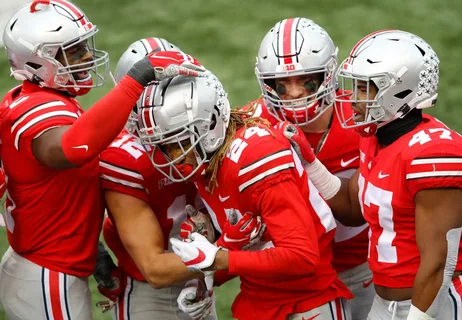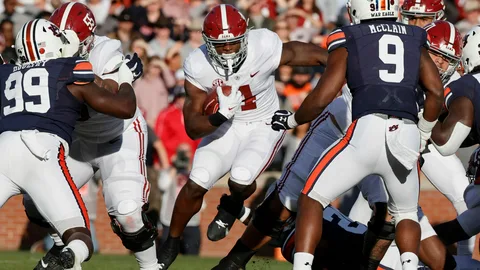The Exciting Journey of the College Football Playoff: Everything You Need to Know
Table of Contents
Introduction
The College Football Playoff (CFP) is one of the biggest events in American sports. Every year, teams compete for the chance to play in the national championship game. It’s a time when college football fans come together to cheer on their favorite teams and celebrate the excitement of the sport. The playoff is more than just a few games; it’s an event that captures the attention of fans across the country.
In the College Football Playoff, the best four teams in the country are chosen to compete for the title. These teams work hard all season, playing tough games and earning their place in the playoff. Fans eagerly await the selection and then follow the games closely, hoping their team will come out on top. The thrill of watching these top teams compete is what makes the CFP so exciting.
But there’s more to the College Football Playoff than just the games themselves. It’s an event that brings people together, from players to coaches to fans. It’s about school pride, community, and the love of college football. In this blog post, we’ll take a closer look at why the CFP is such a special event and what makes it stand out in the world of sports.

What is the College Football Playoff and How Does It Work?
The College Football Playoff (CFP) is an exciting tournament held at the end of the college football season. It features the top four teams from across the country, who are selected based on their performance throughout the season. The CFP determines the national champion by having these top teams compete against each other in two semi-final games, with the winners advancing to the national championship game. The format creates a lot of excitement and allows the best teams to prove they are the true champions.
Each year, the College Football Playoff features teams that have performed at the highest level during the regular season. The teams that make it into the playoff are chosen by a group of experts known as the selection committee. This committee looks at a variety of factors, such as the team’s win-loss record, the strength of their opponents, and how they perform in key games. Teams are ranked based on these criteria, and only the top four are selected to compete in the playoff.
The playoff is structured as a bracket, meaning the top two teams play each other in one semi-final game, while the other two teams face off in the second semi-final. The winners of both games advance to the national championship game, where they battle for the title of college football champions. The playoff is designed to make sure that the two best teams at the end of the season get a chance to play for the national title, creating a thrilling and fair way to determine the winner.
The College Football Playoff system replaced the old BCS (Bowl Championship Series) system, which was often criticized for leaving out deserving teams. With the introduction of the playoff, college football fans now have a more exciting way to crown a champion. The playoff system ensures that the top teams get the opportunity to compete in a way that is more transparent and fair, making it a much-anticipated event each year.
Fans all around the country eagerly wait for the College Football Playoff each season. It’s a time when college football’s best teams come together to put on a show of skill, determination, and passion. Whether you’re cheering for your favorite team or just watching for the excitement of the games, the College Football Playoff is a time that all football fans look forward to. The stakes are high, and the action is always unforgettable.
The History of the College Football Playoff: A Look Back
The history of the College Football Playoff (CFP) begins with the creation of the Bowl Championship Series (BCS) system in the late 1990s. Before that, college football did not have a consistent way to determine the national champion. The BCS system was introduced to rank teams and match them up for the national championship, but it had its flaws. Some fans and teams felt the system didn’t always choose the best two teams to compete for the title, leaving many debates about which teams were truly the best.
In response to growing criticism of the BCS, college football leaders decided to make a change. In 2014, they introduced the College Football Playoff. This new system was designed to create a more exciting and fair way to decide the national champion. Instead of just having two teams compete, the CFP expanded the playoff to four teams, allowing for a more inclusive and competitive tournament. The goal was to ensure that the best teams, based on their performance throughout the season, would have a chance to play for the title.
The first College Football Playoff took place at the end of the 2014 season. The four teams chosen for the inaugural playoff were Alabama, Oregon, Florida State, and Ohio State. The teams were selected by a committee of experts, who carefully considered each team’s record, strength of schedule, and overall performance. Ohio State emerged as the first-ever CFP champion, defeating Oregon in the national championship game. This victory marked the beginning of a new era in college football, one where teams had a more clear and fair path to the national title.
Since its creation, the College Football Playoff has changed the landscape of college football. It has made the end of each season more exciting, with fans eagerly watching to see which teams will earn a spot in the playoff. The playoff has also helped ensure that teams with strong seasons, regardless of their conference, have a chance to compete for the title. Teams like Alabama, Clemson, and Ohio State have become regulars in the playoff, but new teams continue to challenge the old powers, adding to the excitement.
The College Football Playoff has also sparked discussions about expanding the field to include more than four teams. Many fans believe that more teams should have a shot at the championship, especially if they have strong seasons. While the current system has been a success, the future of the CFP may include even more teams, continuing to evolve and shape the way college football crowns its champion.

Top Teams to Watch in the College Football Playoff
The College Football Playoff features some of the best teams in the country, and each year, there are a few standout programs that consistently perform at the highest level. Among these teams, Alabama is always a strong contender. Known for its powerful defense, fast-paced offense, and rich history of championships, Alabama is a team that fans expect to see in the playoff year after year. With Coach Nick Saban leading the way, Alabama has been a dominant force in college football for over a decade, making them a team to watch every season.
Another team that fans keep an eye on is Clemson. Under the leadership of Coach Dabo Swinney, Clemson has become a regular in the College Football Playoff. The Tigers have an explosive offense led by talented quarterbacks and skilled wide receivers. Their strong defense also makes them a tough opponent, and they’ve managed to win multiple national championships in recent years. When Clemson is in the playoff, you can expect them to bring high energy and competitive spirit, making them one of the top teams to watch.
Ohio State is another powerhouse that always stands out in the College Football Playoff. Known for its tradition of excellence, Ohio State consistently fields a talented team. With a strong recruiting program, the Buckeyes bring in some of the best players in the country, and their performances in big games show their readiness to compete. Whether it’s their high-powered offense or rock-solid defense, Ohio State has what it takes to challenge for the national championship, making them a top contender every year.
While Alabama, Clemson, and Ohio State are often favorites, other teams have been making waves and pushing their way into the playoff picture. Teams like Oklahoma and Georgia have shown they can compete with the top programs. Oklahoma’s explosive offense, led by talented quarterbacks, and Georgia’s tough defense and disciplined play have made them dangerous opponents in the playoff. These teams bring something different to the table, whether it’s speed, strength, or strategy, and they are always teams to keep an eye on as the season progresses.
As college football continues to evolve, new teams may emerge as strong playoff contenders. Programs like Notre Dame, Oregon, and Michigan have the potential to challenge for a spot in the playoff and make a run at the championship. With every season, the competition gets fiercer, and the College Football Playoff remains one of the most exciting tournaments in sports. Fans never know what surprises are in store, but they can always count on watching top-tier football from some of the nation’s best teams.
How Are Teams Chosen for the College Football Playoff?
The College Football Playoff (CFP) uses a selection process to choose the top four teams that will compete for the national championship. This process is carried out by a group of experts known as the Selection Committee. The committee is made up of people who have deep knowledge of college football, including former coaches, athletic directors, and former players. They meet regularly throughout the season to discuss which teams deserve a spot in the playoff based on their performance.
To be considered for the College Football Playoff, teams must perform well during the regular season. The committee looks at several important factors, such as a team’s win-loss record, the strength of their schedule, and their performance in key games. Teams that have a strong record and face tough opponents are given higher rankings, as this shows they can compete at a high level. However, a good record alone isn’t enough—teams also need to show they can handle challenging situations during the season.
The selection committee uses a ranking system to help them decide which four teams are the best. Each week, the committee releases a list of rankings called the “CFP Top 25,” which shows how they view each team in comparison to the others. The top four teams in the final ranking at the end of the season are chosen for the playoff. These rankings are based on how teams perform in regular-season games, as well as any conference championships they win. Teams that win their conference title have a strong case for a spot in the playoff, but it’s not a guarantee.
While records and championships play a big role, the committee also considers other factors, such as injuries, key players’ performances, and a team’s overall strength. They make sure to examine all aspects of a team’s season, including how they did against other top-ranked teams. This helps ensure that the four best teams, not just the ones with the best records, are chosen for the playoff. It’s a careful and thorough process that aims to give college football fans the best matchups possible.
Once the top four teams are chosen, they compete in two semi-final games. The winners of these games move on to the national championship game, where they battle for the title of national champion. The selection process can be very exciting and intense, with debates often happening about which teams deserve to be in the playoff. However, the goal is always to make sure the teams that perform the best throughout the season are given the opportunity to compete for the championship.

The College Football Playoff Selection Committee Explained
The College Football Playoff (CFP) Selection Committee is a group of experts responsible for deciding which teams get a chance to compete for the national championship. The committee is made up of 13 members, including former coaches, athletic directors, and players, all with extensive experience in college football. These members are chosen for their knowledge of the game, and their job is to make decisions based on the performance and strength of the teams throughout the season. They meet regularly to discuss the rankings and ultimately decide which four teams will make it into the playoff.
Each week, the committee reviews the performance of teams across the country and releases a set of rankings known as the “CFP Top 25.” These rankings help to show how each team compares to others and are used to determine which teams have the best chances of making it into the playoff. The committee looks at several key factors when deciding on the rankings, such as win-loss records, strength of schedule, quality of wins, and conference championships. Their goal is to make sure that the four best teams, based on these factors, are selected for the playoff.
The selection committee also considers how teams perform in high-pressure situations. They look at how teams perform against tough opponents and whether they win important games, such as conference championship games. A team’s performance in these situations can heavily influence their ranking, even if their overall record isn’t perfect. For example, a team that loses a close game to a strong opponent may still rank highly, while a team that has a good record but hasn’t faced many tough teams may be ranked lower.
One of the most important aspects of the selection committee’s job is to ensure that the rankings are fair and transparent. The committee members are expected to be unbiased and make decisions based solely on the facts and performances of the teams. They are also tasked with explaining their rankings to the public, providing insights into why certain teams are ranked higher than others. This transparency helps fans understand how the selection process works and what factors are considered in the rankings.
At the end of the season, the top four teams in the final rankings are chosen to compete in the College Football Playoff. These teams are matched up in two semi-final games, and the winners move on to the national championship game. The CFP Selection Committee plays a critical role in ensuring that college football’s playoff system remains exciting and competitive by choosing the teams that deserve the chance to fight for the national title.
Why the College Football Playoff Is So Exciting for Fans
The College Football Playoff (CFP) brings an energy and excitement to the sport that is unmatched. One of the reasons it’s so thrilling for fans is the high stakes involved. Unlike regular season games, where teams can afford a loss and still have a chance at a good bowl game, the playoff is do or die. Only four teams get to compete for the national championship, and every game is a must-win. This creates a sense of urgency and tension that builds throughout the entire playoff, keeping fans on the edge of their seats.
Another reason the CFP is so exciting is because of the high level of competition. The teams that make it into the playoff are usually the best of the best, with strong records, tough schedules, and a history of success. Fans love watching these elite teams battle it out, knowing that the winner will be crowned the national champion. The matchups in the playoff are often between teams that have had impressive seasons and have earned their place, which means the games are always close and competitive.
The College Football Playoff also adds an element of unpredictability to the sport. Even though the top teams are usually favorites, anything can happen in a playoff game. Upsets and surprises are a part of the excitement. Fans love seeing underdog teams challenge the giants, sometimes leading to shocking victories that make the playoff even more thrilling. Every year, there are surprises, whether it’s a lower-ranked team making a run or a top contender falling short, which keeps fans guessing and engaged.
Another exciting aspect of the CFP is the way it brings together college football fans from across the country. Whether it’s fans supporting their favorite team or neutral fans enjoying the best games of the season, the playoff unites people with a shared passion for the sport. The atmosphere during these games is electric, with fans cheering loudly and showing their team spirit. The intensity of the games, paired with the passionate fan base, creates a unique experience that is hard to match in other sports.
Lastly, the College Football Playoff is exciting because it culminates in a national championship game that decides the best team in the country. The winner of the championship game is celebrated as the top team in college football, and the journey to get there is filled with drama, excitement, and memorable moments. Fans look forward to this ultimate showdown every season, knowing that it will be a game to remember, filled with excitement and emotions. The College Football Playoff gives fans an experience that makes the entire college football season worthwhile.

The Best Games in College Football Playoff History
The College Football Playoff (CFP) has delivered some of the most thrilling games in college football history. One of the standout games took place in the 2018 CFP National Championship between Alabama and Georgia. This game was packed with drama, as Georgia was leading by 13 points at halftime. However, Alabama made a dramatic comeback, with quarterback Jalen Hurts being replaced by Tua Tagovailoa. Tua led the team to a thrilling overtime victory, making a game-winning touchdown pass. The 26-23 win for Alabama became one of the most unforgettable moments in playoff history.
Another unforgettable game was the 2015 CFP semi-final between Ohio State and Alabama, which was filled with action from start to finish. Ohio State, the defending national champion, faced off against Alabama, a team known for its strong defense and explosive offense. The game saw dramatic plays, including a famous touchdown run by Ezekiel Elliott. Ohio State won the game 42-35, knocking out Alabama and advancing to the national championship game, where they later triumphed. This game showed just how fierce the competition is in the playoff and why fans love watching these high-stakes matchups.
In the 2020 CFP, the game between LSU and Oklahoma was another incredible matchup. LSU was on a mission that year with Heisman Trophy-winning quarterback Joe Burrow, and their offensive performance in this game was nothing short of spectacular. They dominated Oklahoma with a 63-28 win, advancing to the national championship game. The game was a showcase of LSU’s offensive strength, and it remains one of the highest-scoring games in CFP history. The fast-paced action and unstoppable offense made this game a fan favorite, with fans still talking about the amazing performance by LSU’s offense.
Another game that stands out is the 2017 CFP semi-final between Clemson and Ohio State. This game turned out to be a blowout, but it was a huge shock to many fans. Clemson defeated Ohio State 31-0 in a dominant performance. The Tigers’ defense shut down Ohio State’s offense, and their offense ran all over the Buckeyes. This victory was one of the most impressive in CFP history, as Clemson made a statement with a big win, sending them to the national championship. It was a reminder of how anything can happen in the playoff, and it showcased Clemson’s talent and dominance.
The 2021 CFP National Championship between Alabama and Ohio State also provided fans with a memorable game. Alabama’s dominant 52-24 win over Ohio State secured their sixth national title under coach Nick Saban. Alabama’s wide receiver DeVonta Smith had an incredible performance, catching three touchdowns and earning the title of MVP. The game showed Alabama’s skill and efficiency, and it was a great way to cap off a thrilling season of college football.
How the College Football Playoff Affects College Football Rankings
The College Football Playoff (CFP) plays a huge role in determining the rankings of college football teams throughout the season. The CFP Selection Committee releases a weekly ranking of the top 25 teams in college football, and these rankings are influenced by how well teams perform, especially against strong opponents. The committee takes into account a team’s win-loss record, strength of schedule, and overall performance, but the playoff adds an extra layer of importance to these rankings. Teams that are ranked higher in the playoff standings are more likely to be considered for the final four spots in the playoff, so every game counts.
As the season progresses, teams that perform well in the regular season and win important games are rewarded with higher rankings in the CFP Top 25. These rankings not only impact the teams’ chances of making the playoff but also influence their standing in other rankings and polls. For example, being ranked in the top four of the CFP rankings is crucial for teams hoping to play for the national championship. The playoff creates a sense of urgency, where teams must perform at their best to climb the rankings and secure a spot in the playoff. This makes the rankings highly competitive, with teams constantly battling for a spot in the top four.
The College Football Playoff system also influences the way teams schedule their games. Teams ranked lower in the standings will often try to schedule tougher opponents to improve their chances of moving up in the rankings. On the other hand, teams ranked highly may be more selective in their scheduling to ensure they stay at the top. This dynamic affects how teams prepare for the season and how they approach their non-conference games. The hope is that by playing tough competition, teams will improve their rankings and secure a spot in the playoff.
In addition, the College Football Playoff can change the way teams are perceived in the rankings. For instance, teams that win their conference championships are often given a higher ranking, even if their overall record isn’t perfect. This can lead to debates about which teams deserve to be ranked higher. Some teams may have fewer losses but didn’t win their conference, while other teams may have a loss or two but won a major conference championship. The CFP Selection Committee evaluates all these factors and helps shape the rankings accordingly.
Lastly, the CFP rankings can influence the outcome of future seasons. If a team has a successful playoff run, it can boost their recruiting efforts, improve their future rankings, and establish them as a powerhouse in college football. On the other hand, a team that consistently ranks poorly or doesn’t make it into the playoff may struggle to attract top talent and maintain a high ranking in future seasons. The College Football Playoff not only affects rankings during the current season but also has a lasting impact on the future of college football programs.

What Happens After the College Football Playoff: National Champion Crowning
Once the College Football Playoff (CFP) concludes with the national championship game, the excitement doesn’t just end with the final whistle. The team that emerges victorious from the championship game is crowned the national champion, marking the culmination of a season filled with intense competition and drama. The winning team celebrates not only their victory but also the hard work and dedication it took to get to this point. The players, coaches, and fans rejoice, knowing that their team has earned the title of the best in college football for that year.
After the national championship is decided, there’s a lot of recognition and celebrations that follow. The championship-winning team receives the prestigious College Football Playoff National Championship trophy, which is a symbol of their dominance throughout the season. The winning players also earn individual honors, including All-American selections, MVP awards, and other recognitions for their outstanding performances in the championship game. These accolades celebrate the players’ efforts and add to the team’s legacy in college football history.
In the days following the national championship, the attention shifts to the players who will enter the NFL Draft. Many players from both the national champion and the other playoff teams will have the opportunity to showcase their skills at the NFL Scouting Combine and ultimately get selected by professional football teams. The draft brings in a lot of excitement, as college football stars begin their transition to the professional level. The national championship game often serves as a final opportunity for players to showcase their talent before they make the jump to the NFL.
Meanwhile, for teams that didn’t make it to the playoff or didn’t win the championship, the focus often shifts to offseason improvements and recruiting. College football programs begin preparing for the next season by recruiting new talent, building their rosters, and making coaching changes if necessary. Coaches focus on what went wrong in the playoff or season and aim to improve for the next year. This preparation includes working on team chemistry, strength training, and refining game strategies, all with the goal of reaching the playoff the following season.
Finally, the crowning of the national champion marks the end of another thrilling season of college football, but the excitement continues as fans look forward to the next season. The College Football Playoff generates so much enthusiasm, and after the season ends, fans start looking ahead to next year’s championship chase. The legacy of the national champion is celebrated throughout the year, and the buildup to the next season begins almost immediately, keeping fans excited and eager for the return of college football.
Challenges and Controversies in the College Football Playoff
The College Football Playoff (CFP) system, while exciting and thrilling for fans, is not without its challenges and controversies. One of the biggest issues is the selection process itself. The CFP Selection Committee is tasked with choosing only four teams to compete for the national championship, but many fans and analysts argue that the system leaves out deserving teams. For instance, teams with strong records or impressive performances but who don’t win their conference championships may not make the playoff, while other teams with more losses or weaker schedules could earn a spot. This has led to debates about whether the playoff should expand to include more teams and give others a fair chance.
Another challenge in the CFP is the bias some fans believe exists toward certain conferences, particularly the Power Five conferences. Some critics argue that teams from these conferences, like the SEC and Big Ten, are often given more favorable treatment by the selection committee, even when teams from other conferences, like the Group of Five, have strong seasons. This has led to accusations of favoritism and the idea that some teams are automatically considered stronger due to their conference affiliation, even if their actual performance doesn’t always reflect that. Many believe this bias hurts the playoff system’s fairness and leaves out worthy teams from smaller conferences.
The controversy over the CFP’s limited four-team format is another ongoing issue. Fans and pundits alike have debated whether the playoff should expand to include more teams, such as eight or 16, to better represent the variety of talented programs across the country. With the current four-team format, many strong teams are left out of the playoff, and their seasons often feel incomplete, especially when they finish with one or two losses. The expansion of the playoff could give more teams a shot at the national title and reduce the frustration that fans feel when their team is snubbed, but this idea also faces resistance from those who believe the current system is already effective.
Another controversy that often arises is the potential for injuries to key players just before or during the playoff. Teams rely on their star players to lead them to victory, but injuries to these players can dramatically change the outcome of the playoff games. Some fans argue that the timing of the playoff games, especially with the long season leading up to the playoffs, increases the risk of injury. This issue raises questions about player safety and whether college football’s playoff structure should be adjusted to give teams more time to rest and recover before these critical games.
Lastly, the financial aspect of the CFP is also a source of debate. While the playoff generates significant revenue, a portion of that money goes to the conferences and schools that participate. Some argue that smaller programs, especially those from non-Power Five conferences, don’t see the financial benefits they deserve from the success of the playoff. This imbalance has sparked conversation about whether the current system is fair in terms of how revenue is shared across programs. Additionally, the intense pressure to make the playoff puts a strain on schools and players, who often feel the weight of expectations from fans, boosters, and sponsors.

The Future of the College Football Playoff: What’s Next?
The future of the College Football Playoff (CFP) is an exciting topic of conversation for college football fans, coaches, and players alike. With the increasing popularity of the playoff and the debates about its fairness, many people wonder what changes are coming in the future. One of the biggest questions is whether the CFP will expand to include more than just four teams. There is growing support for an expanded playoff, with some calling for eight or even sixteen teams. This would allow more teams to compete for the national championship and give smaller conferences a better shot at the title. It could also reduce the controversies surrounding team selections and create even more excitement as the playoff field grows.
Another possibility for the future of the CFP is how the playoff system will adapt to the ever-changing landscape of college football. With changes in college football conferences and the rise of new programs, the playoff might need to adjust to ensure it remains fair and relevant. For example, the move of teams from one conference to another, such as the recent shifts in the Big Ten and SEC, could change the strength of teams in each conference. These changes may lead to a reevaluation of how the playoff committee selects teams, considering how much weight should be given to conference affiliation versus overall performance.
The format of the CFP games may also see changes in the future. Currently, the playoff games are held in a neutral location, but some have suggested that home-field advantage should be given to the higher-ranked teams. This could create more excitement and a true “road to the championship” feel, where teams have to battle on the road to reach the title game. Additionally, changes to the timing of the playoff could occur to allow for more recovery time for players and to ensure that the championship game is held at a time when it gets the most attention.
As college football becomes more commercially driven, the financial side of the CFP is also something that will continue to evolve. The revenue generated by the playoff is enormous, and there will likely be more discussions about how that money is distributed. Smaller programs and non-Power Five conferences may push for a larger share of the revenue, especially if the playoff expands to include more teams. The future of the CFP will likely involve conversations about how to make the system more equitable, ensuring that all teams, regardless of their conference affiliation, have the opportunity to benefit from the success of the playoff.
Finally, the role of technology and fan engagement will continue to shape the future of the CFP. With the growth of streaming services and social media, fans are more involved than ever before in the playoff process. In the future, we might see more interactive elements, such as fan voting or new ways for fans to engage with the selection process. Technology could also play a bigger role in how teams are evaluated, using advanced data analytics to determine the best teams in ways that were not possible before. This increased fan involvement and technological innovation could make the College Football Playoff even more exciting and accessible to fans around the world.
Why the College Football Playoff Is More Than Just a Game
The College Football Playoff (CFP) is more than just a set of games—it’s an event that brings together fans, families, schools, and even entire communities. For many, it’s a chance to celebrate their team’s hard work and dedication over an entire season. It’s not just about the athletes on the field; it’s about the excitement, pride, and energy that surround the playoff. Fans from all over the country come together to support their teams, making the atmosphere of the playoff unlike any other sporting event. The stakes are incredibly high, and the passion of the supporters makes it feel like much more than just a competition.
Beyond the games themselves, the College Football Playoff serves as a showcase for the entire college football ecosystem. It highlights the top teams, the best coaches, and the brightest stars. The players on these teams often have dreams of playing professionally, and the CFP offers them a stage to shine. Scouts from the NFL closely watch the playoff games, knowing that these athletes are competing at the highest level. The players know that how they perform in these crucial games can impact their future careers, making it a life-changing experience for many.
The playoff also represents a chance for colleges and universities to boost their programs. A team’s success in the CFP brings attention and prestige to their school, and it can help recruit top talent for future seasons. Winning a national championship is a huge achievement, and it can elevate the status of a college football program. For coaches, the success of their teams in the playoff can lead to career advancements, greater recruiting power, and more financial support for their programs. The impact of the College Football Playoff goes far beyond the field, affecting schools in many ways.
The College Football Playoff is also a time for traditions to shine. Each school has its unique traditions, songs, and rituals, and the playoff gives these moments a wider audience. Fans show their school pride by wearing team colors, waving flags, and gathering in large groups to watch the games. The playoffs bring together generations of fans, from young children experiencing the event for the first time to older fans who have supported their teams for decades. It’s an opportunity to create memories that last a lifetime, not just for the players, but for everyone involved.
Lastly, the College Football Playoff is more than just a game because it unites people. Regardless of where you’re from, college football has a way of bringing fans together. Whether you’re cheering for your alma mater or supporting a team from another state, the playoff creates a sense of community and shared excitement. It’s a time when everyone can come together and celebrate the sport they love, making it an experience that transcends just a simple game on the field.

Conclusion
The College Football Playoff is so much more than just a few games. It’s a chance for fans to come together and celebrate their teams, their schools, and the hard work that goes into a long season. The excitement and energy around the playoff create memories that last a lifetime for everyone involved, from the players to the fans. It’s about more than just winning—it’s about pride, tradition, and the love of the game.
In the end, the College Football Playoff is a special event that brings people closer and gives them something to cheer for. Whether your team is playing or not, you can feel the excitement all around. So, the next time the playoff rolls around, remember that it’s not just about the score; it’s about the community, the traditions, and the passion that make college football such a fun experience for all.














Post Comment